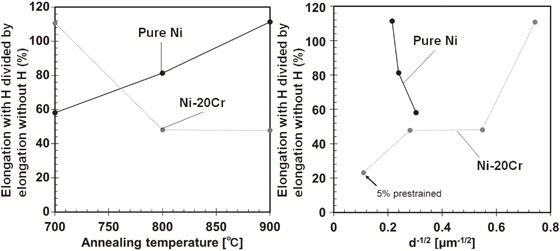1 0 0 0 OA 純NiおよびNi-Cr合金における水素脆化挙動の結晶粒径依存性
- 著者
- 小林 直弘 小山 元道 小林 憲司 北條 智彦 秋山 英二
- 出版者
- 公益社団法人 日本金属学会
- 雑誌
- 日本金属学会誌 (ISSN:00214876)
- 巻号頁・発行日
- vol.85, no.2, pp.49-58, 2021-02-01 (Released:2021-01-25)
- 参考文献数
- 35
- 被引用文献数
- 6 5
The grain size effects on the hydrogen embrittlement susceptibility of pure Ni and Ni-20Cr alloy were investigated. The hydrogen embrittlement susceptibility was evaluated by tensile testing under electrochemical hydrogen charging. Relative elongation, defined as the elongation under hydrogen charging divided by elongation in air, increased with increasing grain size in pure Ni (the grain size was in the range of 11-22 µm). In contrast, the relative elongation of Ni-20Cr alloy increased with decreasing grain size from 13 to 1.8 µm. Correspondingly, intergranular fracture was suppressed by grain coarsening in pure Ni and grain refinement in the Ni-20Cr alloy. In addition, the intergranular fracture surface in pure Ni showed curved slip lines, and in the Ni-20Cr alloy showed straight line marks. These fractographic features imply that the mechanisms of the hydrogen-assisted intergranular crack growth were different in pure Ni and Ni-20Cr alloy and this can be attributed to the difference in stacking fault energy.
1 0 0 0 OA 超高強度低合金TRIP鋼の組織と機械的性質
- 著者
- 杉本 公一 小林 純也 北條 智彦
- 出版者
- 一般社団法人 日本鉄鋼協会
- 雑誌
- 鉄と鋼 (ISSN:00211575)
- 巻号頁・発行日
- vol.103, no.1, pp.1-11, 2017 (Released:2016-12-31)
- 参考文献数
- 132
- 被引用文献数
- 1 24
This paper introduces the microstructure, retained austenite characteristics, strain-induced transformation-deformation mechanism and mechanical properties of transformation-induced plasticity (TRIP)-aided martensitic (TM) steels for the automotive applications. Because the microstructure consists of a wide lath-martensite structured matrix and a mixture of narrow lath-martensite and metastable retained austenite (MA-like phase), the TM steel produced a good combination of tensile strength and cold formability. If Cr and/or Mo were added into 0.2%C-1.5%Si-1.5%Mn steel to enhance its hardenability, the resultant TM steel achieved superior notch fatigue strength and impact and fracture toughness to conventional structural steel such as SCM420. These enhanced mechanical properties were found to be mainly caused by: (1) plastic relaxation of the stress concentration, which results from expansion strain on the strain-induced transformation of the metastable retained austenite; and (2) the presence of a large quantity of finely dispersed MA-like phase, which suppresses crack or void initiation and subsequent connection.
